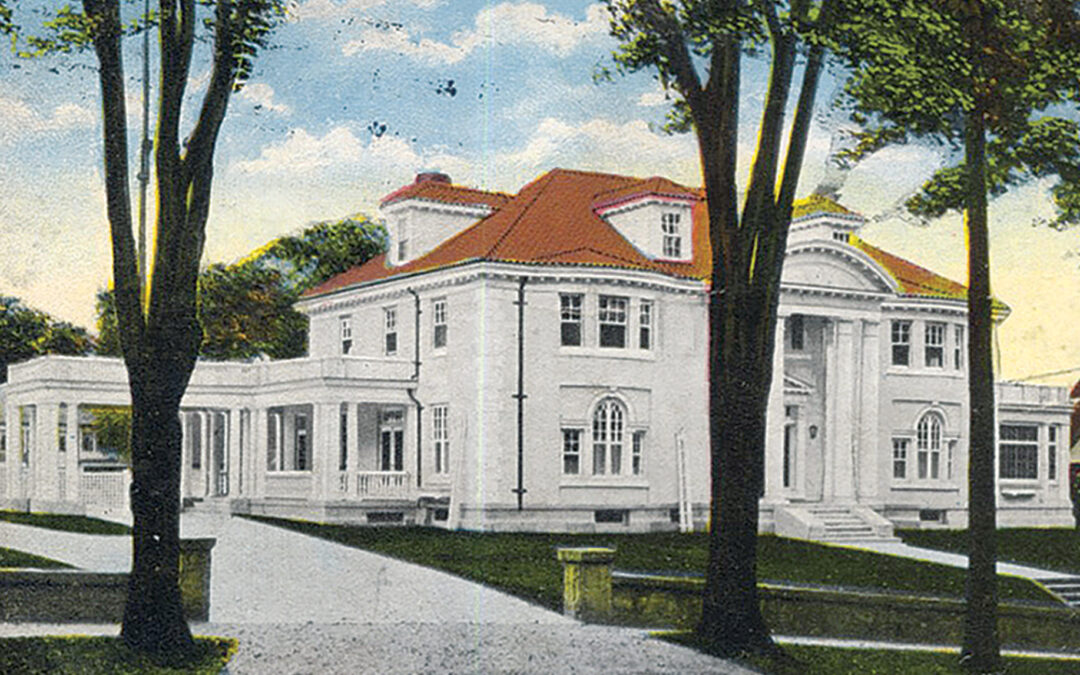The Horatio G. Foss House, nestled within Auburn, Maine’s Main Street Historic District, stands as a testament to the city’s prosperous industrial era. Built in 1914 for shoe magnate Horatio Gates Foss, this stately residence at 19 Elm Street offers a captivating glimpse into the life of a prominent local figure and showcases the enduring elegance of Colonial Revival architecture. Listed on the National Register of Historic Places in 1976, the Foss House is more than just a beautiful building; it’s a tangible link to Auburn’s past.
Designed by the Lewiston-based firm of Gibbs & Pulsifer, the house reflects the wealth and influence of its original owner. Horatio Foss, owner of the Dingley-Foss Company, a major footwear manufacturer employing hundreds, was also a dedicated public servant, having served in the Maine House of Representatives. His home, with its distinctive stucco exterior, red ceramic tile roof, and meticulously detailed ornamentation, embodies the grandeur of the era.
The house’s design seamlessly blends classical elements with practical functionality. The symmetrical facade, anchored by a central entry portico supported by Corinthian columns, exudes a sense of balance and formality. Intricate modillions adorn the cornices and rooflines, while the rounded bays flanking the entrance add a touch of architectural flair. The spacious rooms, including a grand living room with a fireplace, a library, a dining room, and multiple bedrooms, speak to a lifestyle of comfort and refinement. Period details, such as the mahogany banister of the flying staircase, the stained-glass windows, and the meticulously crafted fireplaces, further enhance the home’s historic charm.
Beyond its aesthetic appeal, the Foss House also reveals insights into the domestic technologies and social customs of the early 20th century. Features like a central vacuuming system, a butler’s pantry, and servant’s quarters highlight the household’s reliance on staff. The presence of a porte-cochere and a detached garage, complete with a turntable for easy car maneuvering, reflects the growing importance of the automobile.
The Horatio G. Foss House stands as a remarkable architectural and historical landmark. It embodies the grandeur of its time and provides a window into the life of a key figure in Auburn’s industrial development. Its preservation ensures that future generations can appreciate the craftsmanship, style, and history embodied within its walls.
Last Word – Range Pond State Park
Just a stone's throw from the lively pulse of Lewiston and Auburn, a liquid escape awaits: Range Pond State Park. Picture this: a broad, welcoming beach embracing the sparkling waters of Lower Range Pond, a haven for sun-seekers and splash-makers alike. But the real...
LE Montagnard – Snowshoe Club of Lewiston Maine
As Pictured Above: The 1950 convention brought 3,800 Racqueteers to Lewiston and was profiled by Life Magazine. During one snowshoe convention Lewiston once hosted a magnificent ice palace crafted from the frozen waters of No Name Pond. The 1935 palace was a colossal...
Edward Little – Last Word
A Visionary for Auburn EDWARD LITTLE (1773-1849)Edward Little, a name synonymous with Auburn, Maine, was more than just a philanthropist; he was a visionary who shaped the town’s future. Little was born in 1773 in Newbury, Massachusetts, and graduated from Dartmouth...
Basilica of Saints Peter and Paul – Last Word
BASILICA OF SAINTS PETER AND PAUL EST. 1936As told by Father Patrick J. Finn TO KNOW LOVE With nearly 7,000 weddings between 1873 and 1936 alone, and likely hundreds of thousands more since then, it’s evident that this Basilica holds a special place in the...
John Jenkins – Last Word
EDUCATION AND EMPOWERMENT Graduating from Bates, John Jenkins remained in the community to uplift and challenge his audience to be better people. JOHN JENKINS (1952 -2020)John Jenkins helped me understand what integrity meant… He understood the word ‘endure,’...
Louise Bogan – Last Word
PAIN TO POETRY Originally from Livermore Falls, Bogan faced a hard road to literary success. LOUISE BOGAN (1897 -1970)In a time lacking in truth and certainty, and filled with anguish and despair, no woman should be shamefaced in attempting to give back to the world,...







